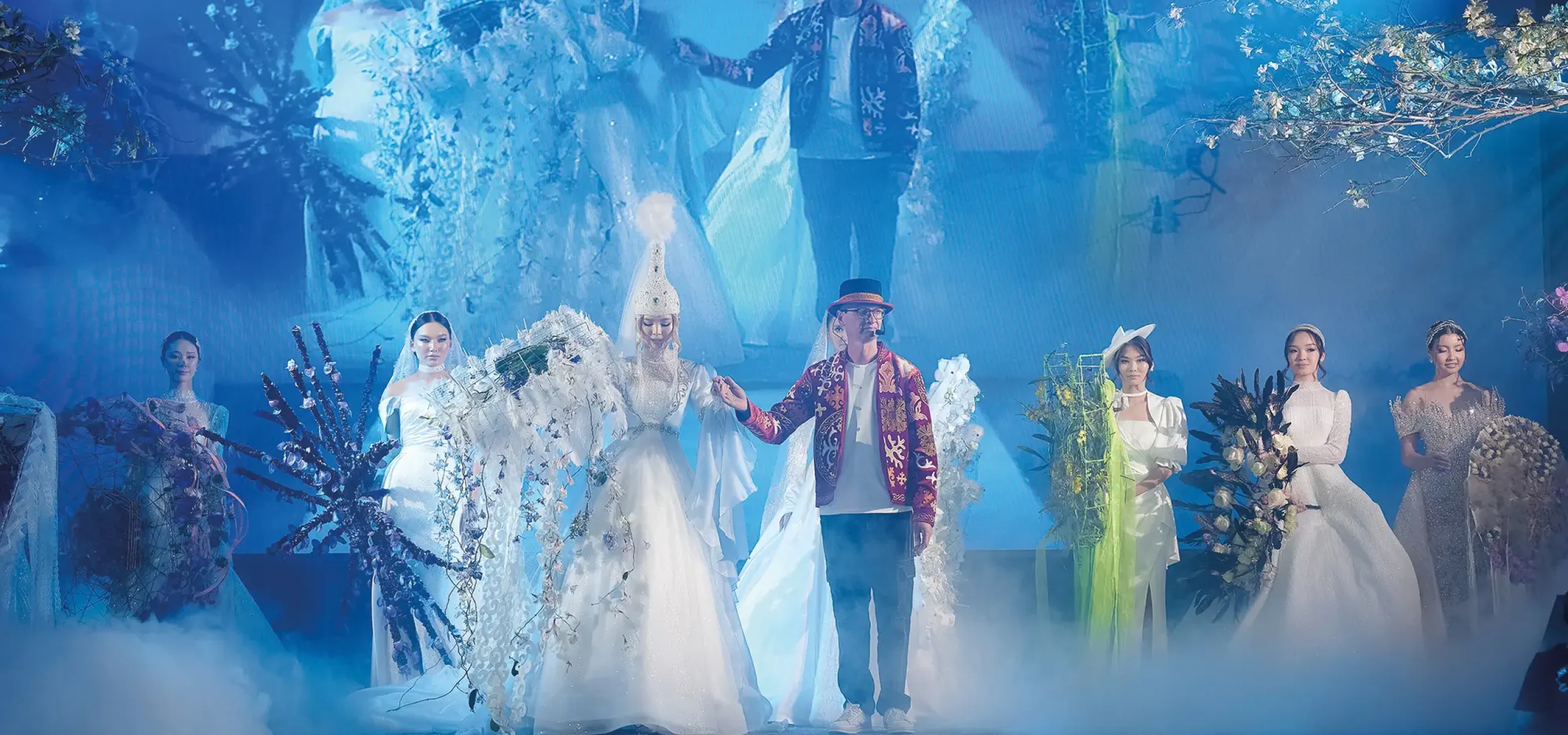
During the event "FloraFusion Kyrgyzstan," flowers, fashion, dance and a live string orchestra combined to form a vibrant scenography. The full-length floral performance, a complete stage ritual, was built around the four seasons, each revealing a different side of Kyrgyz nature and its deep connection to human emotions. With their own material language, atmosphere and dramaturgy. That idea of the different seasons carried the entire storyline of "FloraFusion Kyrgyzstan.
The dramaturgy in seasons gave hold and rhythm. Inspired by the steppes, mountain valleys and the understated beauty of Lake Issyk-Kul, Spring, Summer, Autumn and Winter were told not only in color, but also in movement, light and material. Each part felt different, like pieces of music with their own keys making up a symphony. For producers and florists, a clear capstone that forces choices and concrete collaboration with choreography
and light direction.
Spring
In Spring, models in light dresses slipped between transparent installations like buds bursting open. The compositions in delicate greens and whites depicted the moment when snow gives way and the earth catches light again. 'Air' was interpreted through the use of open structures, slender branches and space between stems. The fresh energy of the season was reinforced precisely by not filling everything up.
Summer
Summer burst open in rhythm and textiles. 'Flowing' fabrics with contemporary interpretations of traditional ornaments danced along with voluminous floral forms. In the choreography of light, color and movement, the flowers herein formed an integrated whole as clothing and floral arrangements mirrored each other in line. Dynamics were created, for example, by extended stems that moved with folds, or by clusters of flowers that accentuated the cadence of a skirt.
Autumn
Autumn brought calm and reflection. Monumen-tal, moon-shaped structures of brown cane materials carried orange roses, interwoven with clematis vines and topped with chestnut bolsters and fruit. The round shape here was metaphor for harvest and completion. It was also a strategic choice: with one supporting formal language, you can still give a large stage a sense of intimacy. Thus, the moon functioned as
visual anchorage where color, texture and meaning came together.
Winter
In Winter, time seemed almost stopped. White wedding dresses with organza and bright lines echoed fields of snow. Arrangements with lilies, Alstroemeria, Nerine and Stephanotis gave the space a subdued atmosphere. The finale, a high-pitched, white bouquet as a gesture of peace, proved how powerful symbolism can be when you minimize everything around it. The silence, and long-held tones of the string orchestra also made this clear. Cutting back on color and quantity in a winter concept ensures that texture and lines carry the emotion above all.
Material Language
The use of materials was also striking. Everyday Kyrgyz raw materials such as grasses (traditionally used for mats), felt, wool and pheasant feathers were given new life in sophisticated floral arrangements. They blended wonderfully with native plants and European cut flowers.
A key part of the concept was therefore ecofloristry: sustainable materials, reusable structures and genuine artistry. It gave the project a forward-looking signature, relevant to any professional who wants to reduce the ecological footprint of events without compromising on imagination.
For Petr Anokhin, FloraFusion Kyrgyzstan was more than a performance - it formed a bridge between generations of artists. 'I wanted to create a story in which the cultural memory of the steppe meets the modern language of global floral art,' says Anokhin. 'Our goal was for the flowers to tell
about identity, peace and harmony.'
Cultural significance
Months of preparation preceded the project. Florists, stylists, photographers and volunteers all contributed - from natural textures and handmade materials to fabrics colored with natural pigments. Most of the flowers were grown and supplied by partners from the Netherlands - Decorum, Flower Portal, Linflowers and Interplant Roses - whose support symbolized the creative bond between cultures. A key figure in international communication was flower expert and blogger Warja Abrosimova. Together with the Dutch companies, she traveled around the world sharing the story of FloraFusion through reports and videos. Partly because of this, the project received wide recognition both inside and outside the world of flowers.
The message behind the aesthetic was clear: floral art can carry meaning. The show was dedicated to peace and to a landmark in the local florist community. That very link gave direction to form and material: the final image in white, the transparent spring, the reflective moon of autumn.
The performance proved that floral art can be a theatrical language in its own right, especially when you take the rules of
scenography - rhythm, contrast, timing - seriously.
Perhaps that is the most important inspiration for the industry: think more in "scene" than in individual arrangements, less in color combinations and more in experiential moments. Then every project can tell a story in which the audience is carried along, from the first pale green sprite in spring to the subdued silence of winter.
- Tell in chapters
The seasonal concept offered clarity for production and audience. Each company had its own color palette, texture and rhythm. It forced choices: what flowers, what carriers, what movement fit this section? A structured storyline makes it easier to manage teams and engage sponsors.
- Work with regional materials
The transformation of grasses, felt and wool shows how local materials achieve a contemporary signature without copying folklore. There is an opportunity here for designers: proximity to materials reduces
logistics and environmental impact and increases the cultural layering of design.
- Build sustainable chains
The collaboration with Dutch growers and exporters illustrates that a strong network increases the quality of floral work, as well as the story.
- Document and share
Good imagery is not an afterthought but a strategic tool to prolong the impact of temporary work, which floral work is.